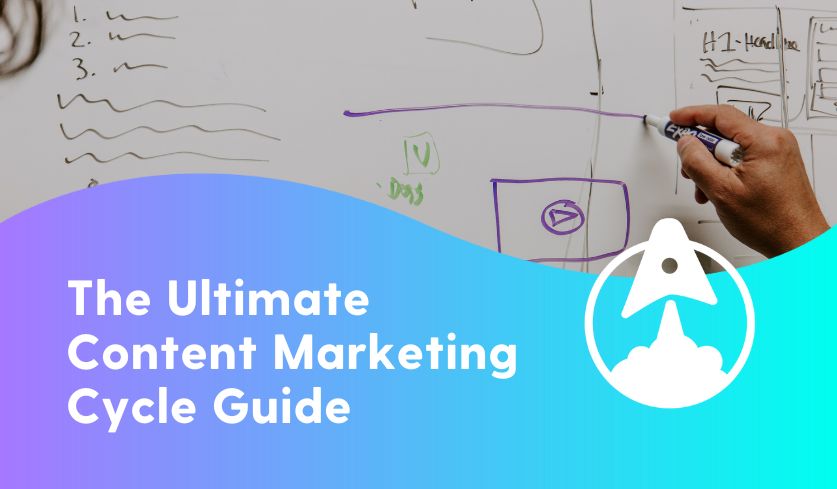If you want your high-quality content to reach future customers, it’s essential to understand the ins and outs of the content marketing cycle. From creating relevant content to understanding the search terms that drive traffic to your website, a well-planned content strategy is key to success. Below, you’ll find a detailed guide on every stage of the content marketing cycle, including how each step is essential to helping your business grow.
What is a content marketing cycle?
A content marketing cycle is a framework for building strong customer connections through blogs, reports, and other web content that resonates. It starts at your first point of contact with a customer and lays the groundwork for fostering a loyal, ongoing relationship. This cycle also puts benchmarks in place so that you can measure what does or doesn’t work along the way.
Similar to any marketing campaign, the content marketing process is designed to give you insight into what motivates your target audiences. From content writing to tracking engagement, a well-thought-out content strategy keeps you organized and helps you improve for your next campaign.
What are the stages of the content marketing cycle?
Research and set your goals
Before you can take action, you need a clear plan, and you’ll create that during the first part of your content marketing cycle. This involves studying your target audience and establishing realistic objectives for your campaign.
To find key audience information, review your customer feedback and surveys, social media followers, and website visitor behavior. This data will help you narrow down what types of content will make the biggest impact. For example, are you trying to spread the word about a back-to-school sale you’re hosting? Have you found that content offering tips and tricks gets the highest engagement? A post on the top ways to make the first week of school a breeze could be a great opportunity to promote your sale.
In addition to what people love about your product, ask yourself: Are there any other common interests your customers share? Subjects adjacent to your company’s mission can make for great content topics. For example, if you sell bicycles, your customer base could also be interested in content about living a healthy lifestyle — one that prominently features biking. It’s also smart to review current SEO trends so you know the current landscape and what your target audience is searching for most frequently.
Also key here: defining exactly what you’re trying to achieve with each content campaign. Are you trying to increase ticket sales for an event? Do you want to increase general awareness for products that meet a need for which people regularly search the internet? If you know which part of the marketing funnel — top, middle, or bottom — is your priority, it’s easier to plan content that captures your audience. (You may see these marketing funnel targets go by some pretty silly acronyms, like TOFU and BOFU.)
Draft content tailored to your target audience
All great content provides value to your customers. Yes, you want to optimize your headlines and keywords so you move to the top of relevant search engine page results (SERPs). But more than that, you should strive to establish your organization as a trusted, knowledgeable source within your niche. This requires a tricky balance of SEO, enticing copy, and thorough research based on credible sources.
You should also consider who might come along and read long after your content marketing cycle has ended. Aiming for evergreen (non-time-bound) language can ensure that your insights remain relevant to future readers. This extends your content’s lifespan and gives you the best ROI possible for all the hard work you put into creating your content. You want content that ages like a fine wine, not something that expires after a week or two. You also want to build in content updates in regular intervals to keep your whole site fresh and relevant to search engines.
If your team doesn’t have the bandwidth to create content themselves, you can always outsource the task to a content writing agency. Experienced content writers can integrate your marketing goals and brand voice into blog posts, web pages, and case studies that your target audience can’t resist.
Share and promote your content
After you’ve meticulously reviewed and edited your content, you can share it with the world.
If you’re intentional with your distribution strategy, your content is more likely to end up in front of your target audience. A great strategy hinges on carefully selecting the right outlets to distribute your content, including social media channels and content syndication platforms.
Try mapping out a posting schedule so you can share your content when it’s most likely to be read. You can time your posts to help promote a product launch or correlate with a relevant holiday while maintaining a consistent posting cadence. If your audience knows when to expect new content, they’re more likely to get into the habit of coming back for more. Many content scheduling tools also enable you to automate and schedule posts so you don’t have to worry about this later.
Sharing your content isn’t a one-and-done activity. In addition to scheduling your initial post, plan out some opportunities to promote your content when mapping out your marketing calendar. Let’s say you’re an ice cream maker who just published a blog about the best artisanal ice cream flavors. If National Ice Cream Day is three weeks after your publishing date, plan a social post for that holiday. Timely promotion gives you the opportunity to get in front of customers who might not have been paying attention the first time.
Measure engagement and apply your results
As the old saying goes, if a tree falls in an empty forest, does it actually make a sound? In marketing, even if you create top-tier content, it doesn’t really matter unless it actually gets read. This is why tracking engagement is such a major step in the cycle. Use analytics platforms to measure key metrics, such as how people are interacting with your website and which calls to action are leading to conversions.
Once you’ve gathered engagement data, review it with an eye for the future. If a certain post is consistently getting high engagement, prioritize similar content for continued success. You can review analytics at the end of a content campaign and at key benchmarks throughout your content marketing cycle. Analyzing your metrics along the way gives you the chance to adjust course or repurpose content that’s suddenly relevant again.
Optimize your existing content
In the world of content marketing, nothing is written forever in stone. You can always revise your existing content so that it fits current SEO best practices or offers something new and relevant to readers, subsequently improving its SEO value. This can range from editing headlines that reflect the kinds of questions customers search for to updating outdated facts or statistics. The right little tweaks can make years-old content relevant once again.
Once you’ve optimized your existing content, repeat the above steps for sharing your content and analyzing the results. Just as with your brand-new content, looking at the metrics on your updated posts can give you helpful insights into what’s on your customers’ minds.
Why is the content marketing cycle important for your strategy?
Curating a good customer experience is essential for growth, but you have to do your research to know what your audience wants. The content marketing cycle gives you all the tools you need to determine if and how you’re meeting your customers’ needs.
The more content cycles you get under your belt, the more data you get for continuing to tailor what you publish to your customer base. Plus, a strong content strategy is vital for attracting new customers and encouraging continued purchases from your existing audience. It’s like if you’re running a bakery and you’re selling out of donuts every day but no one is touching the fruit tarts. When it’s time to update your menu, you know exactly which desserts can get the chop.
5 tools you can use to manage the content marketing cycle
If you’ve got a well-equipped content marketing toolbox, it’s much easier to make all the above happen. Here are some of the best tools to help you manage each phase of your content marketing cycle.
-
- Project management software. You’ve spent so much time putting together a comprehensive content strategy, and now, you want to share it with your team. Project management software such as Asana, Monday, or Trello lets you map out a content calendar and assign tasks, all in one central location.
- Research resources. From finding the right keywords to understanding user behavior, audience research tools can give you the insider knowledge you need to create optimized content. Platforms such as Ahrefs for keyword research and Hotjar for analyzing website visitor behavior can be a huge help in the content planning process.
- Content management systems. Popular CMS platforms such as WordPress allow you to create, organize, and publish your content within user-friendly templates.
- Scheduling assistants. Automated social media posting platforms such as SocialBee let you schedule content posts at preset dates and times. Other social platforms such as Hootsuite also include engagement tracking so you can see which posts get the most traffic.
- Analytics tools. Platforms such as Google Analytics 4 and Google Search Console are free to use and offer robust engagement insights. You can also look into content intelligence platforms that can help you make the right decisions. In addition to extensive performance analysis and content optimization, content intelligence platforms often include CMS and automation features.
Understanding the content marketing cycle is the first step to success
The content marketing cycle provides simple guidelines for creating quality content and measuring your work’s final impact. The more content marketing cycles you complete, the more of an expert you become on creating the best content for your audience.
If you need expert support along the way, The Stellastra Effect will be thrilled to make your content vision a reality. Our award-winning content, spearheaded by an award-winning former journalist, has been proven to boost our clients’ reach. From improving your search engine rankings to increasing your content’s overall impressions, The Stellastra Effect has the tools you need to get your brand noticed.
Book a consultation with us to learn how our services can make the most of your content marketing cycle. You’ll get informative, engaging content that gets your future customers to stop scrolling — and start exploring the products and services that only you can offer.







